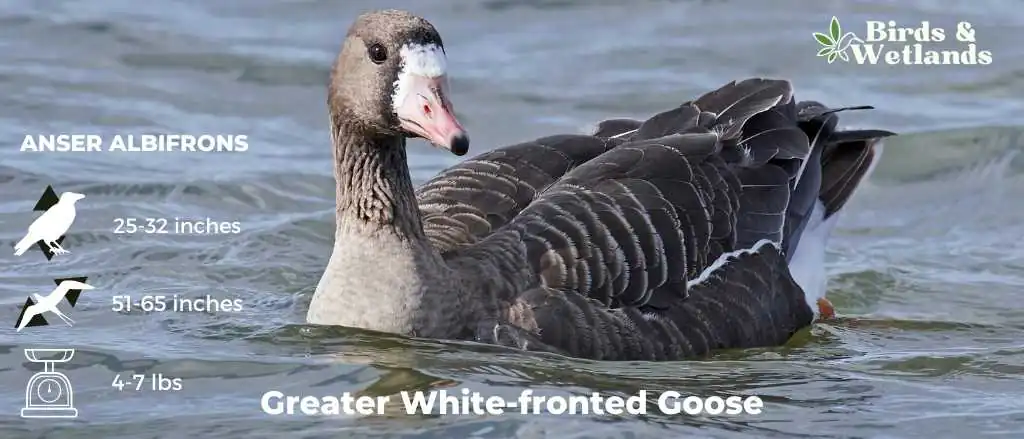The Greater White-fronted Goose is a highly migratory goose species found across the Northern Hemisphere. In North America, this goose is characterized by its stocky brown body, pinkish orange bill, bright orange legs, and a white line down its side. It breeds primarily in the arctic tundra, forming large flocks during the breeding season.
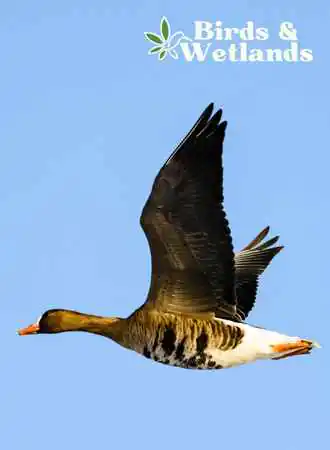
The Greater White-fronted goose is named after the white patch at the top of its bill. These are medium-sized geese. It is named for the patch of white feathers bordering the base of its bill. In fact, albifrons comes from the Latin albus “white” and frons “forehead”. It is related to the lesser white-fronted goose.
Scientific Name: Anser albifrons
Height: 64–81 cm (25–32 in)
Wingspan: 130–165 cm (51–65 in)
Weight: 1.93–3.31 kg (4 lb 4 oz – 7 lb 5 oz)
Description
The greater white-fronted goose is a distinct-looking waterfowl species with an easily recognizable brownish, speckled body and white face patch.
Both males and females have similarly patterned plumage, with black splotches on their bellies, darker brown necks, pinkish bills, a white hip stripe, and contrasting orange legs and feet. Additionally, males are slightly larger than females.
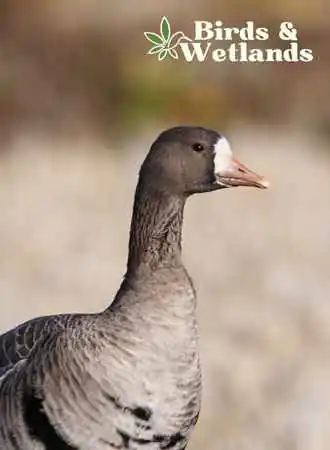
Although these geese are found worldwide, they are colloquially known as ‘specklebelly’ to North Americans for their distinctive salt-and-pepper markings on the breast area.
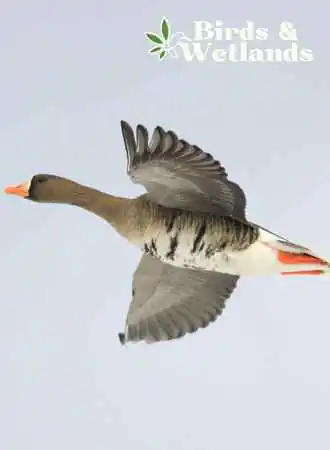
The tule goose is a subspecies of the greater white-fronted goose, with a distinctive plumage that is rich and dark brown. The head and neck, in particular, are much darker than the rest of the body, giving these birds their characteristic speckled appearance.
What sets the tule goose apart from other white-fronted geese is its size; they are larger and have a more elongated structure overall, making them more noticeable in their natural habitat.
Listen to Greater White-Fronted Goose
These geese make many sounds but they are known for their high-pitched cackle.
Habitat & Range
The Greater White-fronted Goose is native to the northern hemisphere in North America and Eurasia. Their breeding grounds are found in open areas such as grasslands, marshes, wetlands, taiga, arctic tundra, alpine meadows, pond edges and lakeshores during the summer months and migrate south for the winter.
They prefer to nest on tundra or lakeshores but will nest on rocky beaches if necessary.
Greater white-fronted geese are often found in mixed flocks with snow geese in the Arctic tundra of North America and far north of Europe, and Asia.
They are migratory birds that breed in Canada, the United States, Iceland, and Greenland. As a long-distance migrant, these wintering birds spend winters in open country in mild climates such as California and Texas. Some flocks may turn up on the East Coast.
Tule geese are a common sight west of the Mississippi River in the winter and they breed in Southern Alaska.
These geese begin departing for fall staging areas in early September.
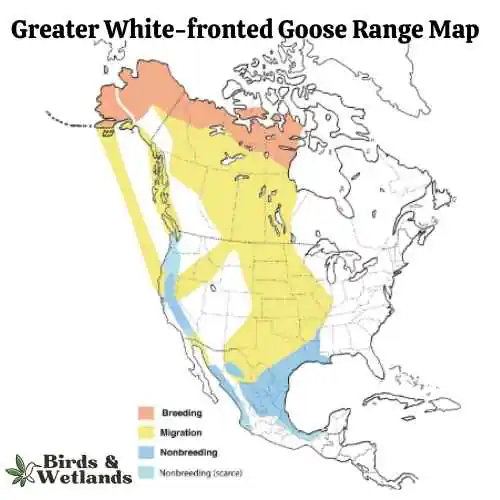
Diet
The diet of the greater white-fronted goose is mainly comprised of plant materials.
During the winter months, this species feeds mostly on seeds and waste grain that it finds in rice fields and other agricultural fields and grazes on new growth found in grasslands and other open areas.
In the summer months, they primarily eat stems and roots of grasses, sedges, horsetails, and other plants, along with berries and buds.
In some cases, they may also feed on aquatic insects or snails, often consuming these species accidentally while feeding on plants.
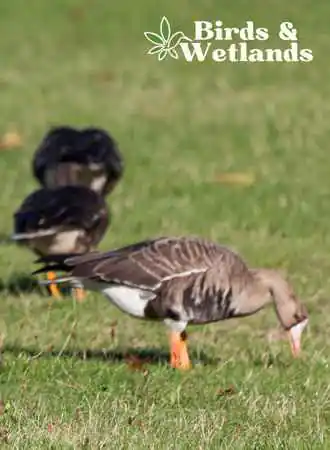
Nesting & Mating Habits
The greater white-fronted goose is known for its distinctive nesting habits. Nesting usually begins by early June. After reaching sexual maturity at around three years of age, the female white-fronted goose builds a shallow depression lined with plant material and down in a sheltered location near the water.
After successfully mating with a male goose, the female typically lays 3 to 6 eggs in her nest site, which she then incubates for 22 to 27 days.
Once hatched, the young white-fronted geese can walk and swim almost immediately, and both parents tend to their young and take an active role in caring for them. The young remain with their parents for the first year of their life.
During this time, these young goslings feed themselves but will continue to rely on their parents for protection and guidance throughout their first year of life. They gain their first flight at 38 to 48 days from hatching.
When they reach adulthood, many of these geese remain closely associated with their family groups for several years, while others will form new pair bonds or join flocks with other geese.
Like most species of geese, the white-fronted geese form lifelong pair bonds with each other. They travel in pairs to their wintering grounds during winter migration.
Population & Conservation
The greater white-fronted goose is a type of migratory waterfowl native to North America and parts of Europe and Asia. Though not as common as the Canada goose, still these geese are found throughout the continent of North America, with populations varying from year to year due to the migratory nature of the birds.
The total population is estimated at 2.1 million individual birds.
Additionally, its conservation status has been rated as Least Concern by the International Union for Conservation of Nature (IUCN), indicating that it remains relatively stable despite fluctuations.
Population By State
| State | Population (estimates) |
|---|---|
| Alabama | N/A |
| Alaska | 30,000 to 50,000 |
| Arizona | N/A |
| Arkansas | N/A |
| California | N/A |
| Colorado | 20,000 to 30,000 |
| Connecticut | N/A |
| Delaware | 10,000 to 20,000 |
| Florida | 1,000 |
| Georgia | 230,000 |
| Hawaii | N/A |
| Idaho | N/A |
| Illinois | 50,000 to 60,000 |
| Indiana | 90,000 to 125,000 |
| Iowa | 100,000 |
| Kansas | 10,000 to 15,000 |
| Kentucky | 40,000 to 50,000 |
| Louisiana | N/A |
| Maine | 83,000 |
| Maryland | N/A |
| Massachusetts | 40,000 to 50,000 |
| Michigan | 200,000 |
| Minnesota | 100,000 to 105,000 |
| Mississippi | N/A |
| Missouri | 40,000 and 60,000 |
| Montana | N/A |
| Nebraska | 150,000 |
| Nevada | N/A |
| New Hampshire | 1,000 to 1,500 |
| New Jersey | 63,000 to 65,000 |
| New Mexico | N/A |
| New York | 200,000 |
| North Carolina | 100,000 |
| North Dakota | 335,000 |
| Ohio | 100,000 |
| Oklahoma | N/A |
| Oregon | N/A |
| Pennsylvania | 230,000 to 232,000 |
| Rhode Island | 3,000 to 7,000 |
| South Carolina | 50,000 |
| South Dakota | 155,000 |
| Tennessee | N/A |
| Texas | N/A |
| Utah | N/A |
| Vermont | 30,000 |
| Virginia | 180,000 |
| Washington | N/A |
| West Virginia | N/A |
| Wisconsin | 170,000 to 175,000 |
| Wyoming | N/A |
Hunting
Greater white-fronted geese, commonly referred to as specklebellies, are among the most challenging game birds to hunt. These large waterfowl are typically very reclusive and discerning in their food choice and habitat, making them difficult to spot and approach.
Despite these challenges, waterfowl hunters in high-quality hunting areas like Arkansas, Louisiana, Texas, and California often have good success when targeting greater white-fronted geese. Additionally, those willing to travel may find more hunting opportunities in other states or regions along the Central and Mississippi flyways where many species of waterfowl such as ducks congregate.
Daily bag and possession limits for greater white-fronted geese are set low to conserve the population of tule geese. This restriction is in place because tule geese are already a threatened species, with numbers slowly declining over the last several years.
These lower limits also help to protect urban and farm fields from potentially damaging goose populations and give these connected habitats time to recover from ravenous flocks of white-fronted and light geese.
Additionally, resource managers must consider that it can be difficult to distinguish between regular and tule greater white-fronted geese in the field.
By keeping daily bag limits low, they can reduce their margin of error when harvesting these birds, ensuring that more tule geese will be undisturbed throughout their migration cycle. In many states, the daily bag limit of these goose species is included in the same limits for Canada geese.
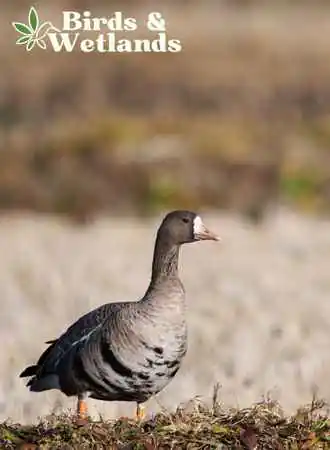
Key Points
Greater White-fronted Goose (Anser albifrons) is named for the white patch at the top of its bill.
The tule goose is a dark subspecies with distinctive plumage that is rich and dark brown.
It has a block splotching on the belly and a white band at the tip of the tail.
Both males and females have similarly patterned plumage but males are larger than females.
Females typically lay 3 to 6 eggs, which they incubate for 22 to 27 days.
These geese spend winters mainly west of the Mississippi River and the Gulf Coast. Some flocks, particularly the tule geese, winter in the Pacific Northwest.
Most of the Pacific population of these geese is in California.

